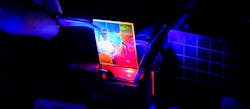NTU Singapore researchers show that quantum-dot lasers can be electrically pumped
Scientists from Nanyang Technological University, Singapore (NTU Singapore) have developed a way to make colloidal quantum dots (CQDs) produce laser light with the help of an electric field. CQDs, semiconductor nanoparticle light emitters that efficiently generate vivid and saturated colors, are being used more and more in display screens of electronic devices. Though CQDs should be promising as laser materials, they are not yet practical since they need to be powered via optical pumping. However, this renders them too bulky for use in semiconductor electronics.
Over the last few years, researchers have tried various approaches to make it easy to use CQDs in lasers, including electrochemical methods and chemical doping. These approaches require the use of harsh chemical solvents or oxygen-free environments in their production, and so have been limited to lab-scale experiments.
Now, NTU assistant professor Steve Cuong Dang and PhD student Yu Junhong have demonstrated how an electric field can help CQDs emit laser light while using only a fraction of the energy traditionally required to drive a laser.1 In their experiments, the NTU scientists embedded CQDs between two electrodes, which provides an electric field to control and change the properties inside the CQDs. By manipulating these properties, the scientists lowered the energy threshold needed for lasing by around 10%, bringing the prospect of CQD lasers closer to reality.
This threshold reduction is the first time researchers have lowered it using an electric field, instead of difficult-to-use electrochemical methods.
Being able to build single-material low-cost compact lasers that are electrically driven in a wide range of colors is the holy grail for many optical and optoelectronic researchers. Lasers are the backbone technology for various industries including medical, security and consumer electronics, and are essential to the development of laser televisions.
CQDs are easily and economically produced in simple liquid-phase chemical syntheses, and their optical and electronic properties can be altered and controlled by varying the particle size. Colloidal nanomaterials are attractive to laser makers due to their low cost, tunable emission color, and high emission efficiency. However, getting them to lase currently requires fast, intense and coherent optical pumping, whereas electric pumping is slow, weak and incoherent.
Dang worked with collaborators Hilmi Volkan Demir and Wang Hong from EEE, and Sum Tze Chien from the School of Physical and Mathematical Sciences. “The next big challenge in laser research is to develop nano-scale lasers and integrate them into on-chip photonic devices and ultrasensitive sensors. This would bring significant impacts to modern society especially in data and information processing, that is driving the fourth industrial revolution. Achieving it would be a major advance within Singapore’s Industry 4.0 transformation,” says Demir.
The team is now looking into making CQD lasers on a chip and working with industry partners keen to develop the technology into proof-of-concept devices with practical applications.
This interdisciplinary project was funded by Ministry of Education, National Research Foundation Singapore (NRF) and Agency for Science, Technology and Research (A*STAR), and involved PhD student Yu Junhong and Dr Sushant Shendre, a research fellow at NTU’s LUMINOUS! Centre of Excellence for Semiconductor Lighting and Displays.
REFERENCE:
1. Junhong Yu et al., Science Advances (2019); doi: 10.1126/sciadv.aav3140.

John Wallace | Senior Technical Editor (1998-2022)
John Wallace was with Laser Focus World for nearly 25 years, retiring in late June 2022. He obtained a bachelor's degree in mechanical engineering and physics at Rutgers University and a master's in optical engineering at the University of Rochester. Before becoming an editor, John worked as an engineer at RCA, Exxon, Eastman Kodak, and GCA Corporation.
